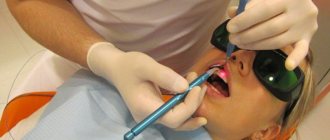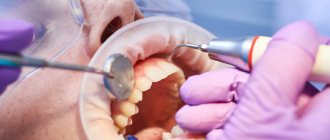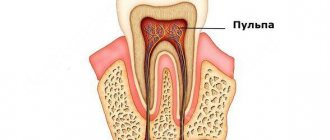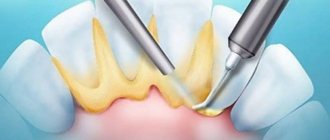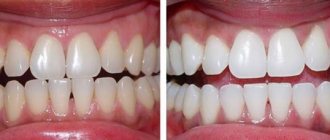Causes of tartar
Stone is a common problem; it forms in all people due to the peculiarities of the modern lifestyle. But the speed at which it appears is different for everyone. Hard plaque forms faster as a result of the following factors:
- insufficient oral hygiene;
- predominance of soft foods, sugar and fast carbohydrates in the diet;
- uneven chewing of food on each side of the jaw;
- excessive consumption of black tea and coffee;
- smoking;
- metabolic disease;
- saliva is too viscous.
Preventive measures
The best prevention in this case would be a systematic visit to the dentist for professional cleaning. Experts in the field of dentistry and hygiene recommend undergoing the procedure at least once every six months. If the patient smokes or often drinks coffee and strong tea, prof. hygiene every 4 months, but on this matter you need to consult with your doctor - it all depends on the current condition of the enamel and its individual characteristics.
Proper dental hygiene is important to maintain your smile.
As mentioned above, you should periodically use an ultrasonic or electric brush, as well as a special abrasive paste with an RDA index above 1202 - this indicator will be indicated on the packaging. Just remember that you cannot constantly use such a product, as it can harm the enamel layer. It is better to alternate it with fluoride-containing and regular prophylactic paste. You also need to remember to use floss, rinse your mouth every time after eating, and it is better to purchase an irrigator to clean the interdental spaces and hard-to-reach places. It is recommended to consume hard vegetables and fruits more often - the moment you bite into an apple or, for example, a carrot, natural plaque is removed from the enamel
How to detect tartar
You can do this at home in front of a mirror. Carefully examine your teeth from the outside and inside. The stone is located on the surface of the enamel and in the gum pockets. It is most pronounced on the inner side of the lower incisors. Tartar is divided into supragingival and subgingival.
Supragingival plaque is easier to detect; it covers the visible part of the enamel and has a yellow or brown tint. In a neglected state, it provokes the formation of caries. Signs of such a stone are bad breath, the appearance of pigment spots, and darkening of the enamel.
Subgingival plaque can only be detected by a doctor. This stone forms in the periodontal pocket—the area where the gum covers the tooth. The plaque has a dark brown or greenish-black tint. If neglected, it leads to the formation of periodontitis. This disease is dangerous due to the loss of healthy teeth. A distinctive sign of subgingival plaque is bleeding and increased sensitivity of the gums.
Comments from dentists
Dentists do not recommend the use of sodium bicarbonate in the fight against tartar.
Valery Leontiev, dentist, member of the Russian Dental Association. Tartar adheres firmly to the tooth tissue, so it must be removed only by special methods from a professional. Baking soda can only remove mild plaque from teeth. By self-medicating, you can damage tooth enamel.
Victor Vasiliev, dentist, director of the dental clinic. The use of soda is ineffective in the fight against hard dental plaque, especially subgingival plaque. Despite the fact that it is part of professional teeth cleaning products, it is worth remembering: in dentistry, in addition to powdered products, special devices and instruments are also used. This medical procedure cannot be repeated at home.
Teeth cleaning from tartar in the clinic
In dentistry, to remove tartar, you can use the service of professional teeth cleaning (or professional oral hygiene). This service is available in almost all dental clinics. Several professional methods are used to remove tartar:
- Ultrasonic cleaning. This is the most accessible and widespread method. The doctor uses a special device - a scaler. It creates low-frequency vibrations that gently peel away hard deposits from the enamel. The doctor then uses water and air pressure to cleanse the mouth. Ultrasound is suitable for both supragingival and subgingival deposits. This method is safe for enamel and gums. At the end of the procedure, the dentist polishes and fluorides the teeth to reduce sensitivity and strengthen them.
- Laser cleaning. The procedure is similar to ultrasonic cleaning, the only difference is in the device used. Laser is considered a more modern method, effective and safe. The advantage of this method is that the laser promotes rapid gum regeneration and has an antibacterial effect.
- Air Flow. A modern way to clean the mouth. More expensive compared to the first two options. For cleaning, the doctor uses a pressure consisting of water, air and sodium carbonate. This method differs in that in addition to removing tartar, the enamel is also lightened.
There are also options for chemical and mechanical cleaning, but due to their traumatic nature and low efficiency, modern clinics do not use them.
How to remove stone in dentistry
The best way to combat plaque and deposits is professional cleaning. Today, as part of this procedure, dental clinics offer various techniques. Let's look at them in a little more detail:
- Air Flow sandblasting is a popular technique that is based on cleaning using a water-salt solution. It is supplied under high pressure and allows you to remove hardened deposits in hard-to-reach places. The smallest particles of the mixture literally beat off plaque and pigments from the enamel surface. For some time after the procedure, teeth may remain sensitive, especially to temperature changes in food and drinks. After cleansing, it is better to limit the consumption of coloring products, coffee, tea and smoking,
The photo shows the method of brushing teeth with the Air Flow system. - ultrasonic cleaning – under the influence of an ultrasonic scaler, the stone literally breaks down, turning into powder. Thanks to the simultaneous supply of water, the remaining plaque and hard deposits are easily and quickly washed away from the surface of the teeth. The technology allows for effective cleaning of gum pockets. The procedure is often performed in combination with Air Flow and is absolutely painless for the patient. After cleaning, the enamel is polished and coated with a fluorine-containing compound to further strengthen hard tissues,
Using the Vector ultrasound device, a specialist cleans periodontal pockets
“I am a regular client of your clinic, and I decided to express my gratitude with this review. I have treated your caries several times and for several years now I have been having my teeth cleaned here with Air Flow, at least once every six months. I really like the quality of service, the work of the staff and the atmosphere in general. Thanks to the efforts of your specialists, the procedure is always quick and absolutely painless. Your smile becomes snow-white, and no whitening is necessary! Personally, for me the effect lasts all these six months, until the next cleaning. True, I don’t smoke or drink coffee, I try to take care of my health...”
Marina A.K., Moscow, fragment of a review on the website of a dental clinic
- dry cleaning – special chemical reagents are also used to effectively break down hardened contaminants. Their help is resorted to in cases where ultrasound and sandblasting are ineffective. Hydrogen peroxide and compositions with abrasive particles are used as preparations.
The photo shows chemical teeth cleaning - Hand Cleaning – Hand tools can also be used to remove pigmented areas. These are small thin hooks with which the specialist “catches” the accumulations under the gums and carefully removes them from the pockets.
The manual method uses hooks for cleaning.
Gradually, hardened deposits will begin to destroy hard tissue, which can easily lead to caries. The microabrasion procedure will help stop this process. The essence of the technology is gentle polishing of the enamel surface, which carefully removes pigmented spots and prevents further development of the pathological process.
As part of the procedure, the specialist removes a very thin layer using a special abrasive composition. The layer thickness usually does not exceed 25-70 microns, so there is no need to worry about thinning of the enamel and its increased sensitivity. In complex clinical cases, up to 200 µm is sometimes removed1. The procedure is relevant for patients who have heavily contaminated and pigmented areas when they do not respond to the above cleansing methods. Indications for its treatment also include a spotted form of hypoplasia, caries at the “white spot” stage and signs of demineralization.
How to remove tartar at home
On the Internet you will find a dozen options for quickly removing tartar using available means: soda, hydrogen peroxide, vinegar, salt, herbal decoctions. We strongly do not recommend using any of them, because they are all ineffective and potentially dangerous. Why you can’t use home methods for removing tartar:
- When using soda and salt, abrasive particles damage the enamel.
- Solutions with vinegar and soda can damage the mucous membrane and cause burns.
- These methods are ineffective. For example, subgingival deposits can only be removed in the dentist's office.
- Herbal decoctions can stain the enamel, after which whitening will be required.
- Partial destruction of the enamel is possible.
- It is very easy to go overboard with the exposure time or dosage of these products.
What does traditional medicine offer?
Some folk remedies can help you remove plaque and pigmentation on your teeth. However, they can only be used in practice with the permission of your dentist. Below are the most popular and proven traditional medicine recipes.
Recipe with black radish
The cleansing effect in this case is based on the action of acids contained in radish, but for maximum results it is used in combination with lemon juice. It is enough to grate the radish and add lemon juice to the resulting mass. The resulting product should be thoroughly chewed or treated with a brush on the surface of the teeth, and the remainder should be spat out. It is recommended to carry out the procedure after evening cleansing.
Black radish with lemon helps with plaque
Horsetail decoction
To prepare the decoction, you need to take 3 tablespoons of the dry plant and pour a glass of boiling water over them. Pour the resulting mixture into an airtight container and preferably insulate it with a towel. After complete cooling, the solution should be filtered and then used to rinse the mouth in the morning and in the evening.
Gargles with honey
To soften lime deposits, you can also use rinses with the addition of honey. It is enough to dilute one tablespoon of natural honey in a glass of warm water. The resulting product is recommended to be used every evening for a month.
Honey dissolved in water softens dental plaque well.
Walnut bark recipe
The nut bark and young branches of the plant must first be thoroughly washed, dried and crushed. Next, 100 g of raw material should be poured with a glass of boiling water and heated in a water bath for 15 minutes. Then you need to take a toothbrush and dip it in the resulting broth, and then proceed to regular brushing.
Walnut bark is often used in home cleaning
A solution of bean husks and burdock root
To prepare the composition, take a few tablespoons of burdock and chopped beans. The raw materials need to be filled with water and boiled for a couple of hours. After this, the broth should be filtered and used to rinse the mouth. The procedure can be performed up to four times a day.
Cleaning enamel with soda
Baking soda powder can be used for abrasive cleaning. A small amount of the product is added to a regular prophylactic paste. Just remember that too frequent use of such products has a negative impact on the condition of the enamel. Therefore, you need to use this mixture carefully, preferably in courses or no more than twice a week.
Baking soda is often used to clean teeth at home.
Hydrogen peroxide to remove plaque and soft deposits
Peroxide oxidizes organic compounds, softens limescale formations and helps get rid of bacterial plaque. For use at home, a 3% solution is recommended, since a higher concentration can cause a burn to the mucous membrane. First you need to brush your teeth with regular toothpaste. After this, a tablespoon of peroxide should be dissolved in a glass of warm water. Rinse your mouth with the prepared solution for a minute. After the procedure, it is not recommended to eat or drink for half an hour.
Hydrogen peroxide softens dental plaque
Decoction of linden flowers
To prepare the product, you need to take 4 tablespoons of dried flowers of the plant, add to them some crushed sunflower baskets without seeds and add a liter of water. The resulting mixture should be boiled for half an hour, after which the broth should be strained and used as a mouth rinse as needed.
Birch sap for prevention
Birch sap itself has a pronounced antioxidant effect. This is an excellent tool for preventing the formation of heavy plaque. It is enough to drink at least one glass of birch sap a day to significantly reduce the intensity of the formation of lime deposits and the risk of tartar.
Birch sap has an antioxidant effect
Prevention of tartar formation
Why do stones form on teeth? Primarily due to insufficient oral hygiene. Daily care should include brushing your teeth using a brush and toothpaste, mouthwash and dental floss. Carry out comprehensive cleaning twice a day: morning and evening. It is important to choose the right care products depending on the hardness of the brush, the composition of the paste and rinse aid, and the thickness of the thread. For example, a brush that is too hard can damage the enamel and mucous membranes, while a brush that is too soft will not clean plaque properly. You can choose hygiene products during a consultation with a dentist.
In addition to daily care, prevention also includes regular visits to the dentist. You must come for a routine examination and professional oral hygiene at least twice a year.
How to clean teeth from tartar? First of all, in the dentist's office. At home, you can only prevent stone formation through proper cleaning. The doctor will select the professional hygiene option depending on the condition of the teeth and gums and the patient’s personal preferences. Tartar cannot be ignored. Even if it does not bring noticeable discomfort, it is dangerous for the development of oral diseases, in particular, caries and periodontitis.
Plaque removal methods
The easiest way to reduce the risk of plaque accumulation is to include solid fruits and vegetables in your daily diet. But if you need to remove a hard formation, then only special brushes, tooth gels, and pastes are suitable for removing tartar.
Let's look at the main ways to remove partially mineralized tartar at home.
Toothpaste, gel
Regular toothpaste will not work in this case. It is recommended to choose a paste containing pyrophosphates and zinc compounds, abrasive and grinding components, papain, bromelain.
When purchasing a product, pay attention to the RDA level, which indicates the size and number of abrasive particles. To cleanse hard plaque, you should choose toothpastes and gels with an index of 100 units or more. For sensitive teeth - no more than 25. The optimal amount of fluoride and fluorides should be contained in the paste from 0.1 to 0.6%.
Among the most effective toothpastes are:
- PRESIDENT White Plus. At the stage of the appearance of stones and their incomplete mineralization, this paste easily removes all formations. However, dentists do not recommend using toothpaste to remove tartar every day. It will be enough to brush your teeth with it once every 7 days.
- LACALUT White. Whitening toothpaste contains abrasives and pyrophosphates, which help remove stone. But, like the previous option, the paste cannot be used every day.
Precautionary measures
Using any home method for removing tartar requires:
- Consultations with a specialist. This will help avoid negative consequences and reduce the risk of harm to the body.
- Avoid using a toothbrush or use only soft bristles.
- Brushing your teeth with a toothpaste high in fluoride and calcium.
- Do not allow the mixture to come into contact with the gums and other mucous membranes.
- Do not exceed the exposure time of soda to the enamel.
Effective recipes
Dry soda
The use of dry powder is considered one of the most aggressive methods of sanitation of the oral cavity using soda. A small amount is applied to the surface of the teeth and rubbed thoroughly.
Attention! When applying sodium bicarbonate in any form to tooth enamel, do not use a toothbrush. It is acceptable to use cotton swabs, gauze swabs and turundas.
Concentrated solution
Add soda in small portions to a small amount of water and mix thoroughly. As soon as the powder stops dissolving, the concentrate is ready. Use the resulting liquid to brush your teeth, then rinse your mouth with clean water.
Using foil
To increase the duration of exposure of the soda to the teeth, use foil. Two strips are made from it, onto which a mixture of soda and toothpaste is placed, after which they are wrapped around the upper and lower row of teeth. These foil mouthguards are left in the mouth for 1 hour, then removed and rinsed with clean water.
This method can be used once a week.
Enrichment of toothpaste
Add a pinch of soda to any toothpaste immediately before brushing your teeth. But for maximum enamel protection, it is better to use a fluoride-containing paste with a fluoride concentration of at least 1400 ppm.
Reference. In this case, using a toothbrush is acceptable, but preferably with soft bristles.
With salt
Soda is mixed with dry salt in a 1:1 ratio and a little water is added until a paste is obtained. Use the prepared mixture to brush your teeth 1–2 times a week until the desired effect is achieved.
With iodine
Dissolve 1 tsp in a glass of warm water. soda and add 1 drop of iodine. Rinse your mouth with this solution after each brushing of your teeth.
With hydrogen peroxide
Attention! Hydrogen peroxide is considered an aggressive solution for teeth and oral cavity. Therefore, the product is used no more than once a month.
A small amount of a 3% solution is mixed with soda to form a thick paste, which is rubbed into the enamel for 2 minutes. Then rinse with water.
Carefully! In case of contact with the gums, a burn of the mucous membrane with lightening of the surface is possible. In such a situation, it is necessary to stop the procedure and rinse off the product with clean water.
With fruit acids
Fruit acids enhance the cleansing effect of soda and also lighten the tone of the enamel. Lemon is best suited for these purposes, but you can use grapefruit and kiwi.
Add a few drops of sour fruit juice to the dry powder and rub the teeth for 1 minute. The procedure is repeated no more than 1–2 times a month.
Remember. The mixture with acids has a very aggressive effect on the teeth; frequent use can damage the enamel.
With strawberry
Strawberries have whitening properties, so they are used not only in cosmetology, but also to lighten tooth enamel.
The pulp of fresh berries is mashed, a pinch of soda is added and the teeth are rubbed. This composition is kept in the mouth for 2-3 minutes.
With activated carbon
An activated carbon tablet is crushed to a powder and mixed with soda 1:1. Dip a toothbrush into the resulting mixture and brush your teeth for 1–2 minutes. After this, rinse your mouth with clean water.
This cleaning is used 1-2 times a week.
Attention! Charcoal can stain dentures, crowns and fillings.
Contraindications for use and side effects
The use of soda is prohibited in the following cases:
- Acute gum diseases, such as gingivitis and periodontitis, accompanied by swelling, bleeding and redness.
- Subgingival calculus.
- Increased sensitivity of teeth.
- Crowns and dentures installed in the mouth, as well as fillings, especially on the front teeth.
- Orthodontic structures fixed to the teeth, such as braces.
- Individual intolerance to soda and other components.
The use of soda mixtures can lead to unwanted side effects:
- thinning of enamel;
- fragility and increased sensitivity of teeth;
- change in color of installed fillings and dentures;
- chemical damage to the oral mucosa.
If you experience increased tooth sensitivity or gum damage, stop using soda and consult a dentist.


